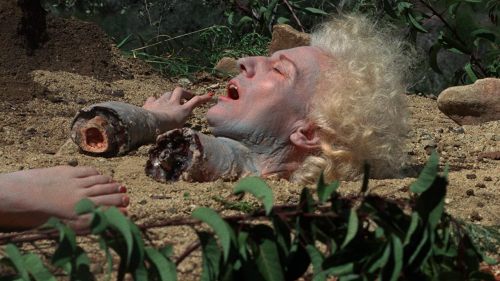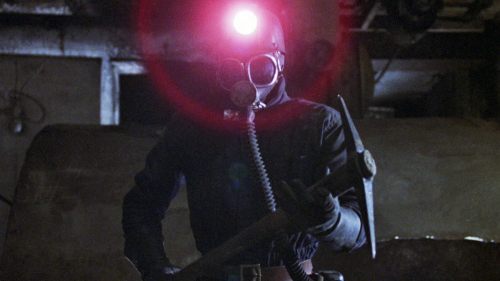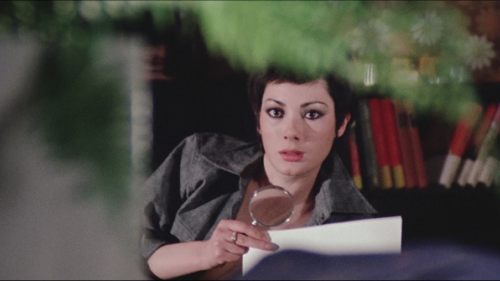INSIDE Film Review: The Mother Of Re-Invention
Those familiar with the New French Extremity horror wave that rose to prominence during the early-to-mid aughts know how good Inside ('09) is. Julien Maury and Alexandre Bustillo's home invasion gorefest spills an amount of karo syrup that can only be described as "preposterous". Yet the ludicrous amount of bloodshed is actually what makes that film feel truly transgressive, as Maury & Bustillo crafted a veritable cinematic car crash, daring you to look away as a pregnant widow's home is broken into by a mysterious stranger, who wants the woman's baby for her own. The French fright freaks were pushing the boundaries of good taste, and shattering genre taboos with the mere concept alone. To add this many grotesque puncture wounds to an already preloaded deck seemed like cheating, in a way. We're on the edge of our seats, both terrified for the expectant mother's safety, while gawking at the cartoonish cavalcade of carnage.
That said, it's still somewhat easy to understand why Inside would become a candidate for an English-language remake (despite the fact that it's, in actuality, a Spanish production, headed by the [REC] series' Jaume Balagueró). Like Thomas Alfredson's Let the Right One In ('08), the premise is so simplistic that any filmmaker worth their chops could arguably find a way to apply their own filmic fingerprint. The fact that Miguel Ángel Vivas was hired to helm the new script - which was co-written by Balagueró and Manu Díez ([REC] 2 ('09) and [REC] 4: Apocalypse ['14]) - led one to believe that's how the new picture was being handled. Vivas had already proven with Kidnapped ('10) that he knew damn well how to make a home invasion horror movie, full of split screens and unflinching brutality. The combination of material and talent seemed perfectly matched, even if you thought Inside didn't technically "need" to be remade (but really, what movie does?).
The set up is the exact same, with this Sarah (Rachel Nichols, from Star Trek ['09]) trying to ward off a nameless Laura Elena Harring (Mulholland Drive ['01]), who breaks into her home and will not quit until she's cut the child from her adversary's womb. The look of the movie is slick; cinematographer Josu Inchaustegui (Extinction ['15]) exploiting the suburban Chicago house for all its hidden sinsiter vibes, a homemaker's dream suddenly transformed into a cozy prison cell. Flashes of rather wonderful style are injected throughout - a slow motion dash to the bathroom becoming rather balletic in terms of its choreography - as editor Luis de la Madrid (The Machinist ['04]) keeps the movie's scant 88-minute runtime skating along gracefully. To wit, this is an objectively well-made motion picture from seemingly every technical stand point.
So, why does the whole of this Inside feel so flat? Perhaps it's because the movie eschews the original's wanton severity in favor of a more grounded approach. Suddenly, the primary motivation for many who viewed Maury & Bustillo's splatter freak out is gone. Vivas instead chooses to linger on the emotional toll a life or death struggle has on the individuals involved. Not a novel concept, to be sure, yet the filmmakers explore this theme in somewhat peculiar ways, such as a dying man tortured with a cell phone photo of his beloved as he lets his last breath go. The performances are all uniformly solid - though not one is an out and out showcase of any kind - as both women (not to mention the performers playing cops and family members who unfortunately stumble into this fiasco) sell us on the reality of the terrifying scenario well enough.
"Well enough" - that somewhat half-assed praise is exactly the problem: the movie is made "well enough" to probably earn its meager budget back through digital sales; fodder for a slow Friday night when you don't want to leave the apartment. The educated horror fan is going to rent this new Inside mostly out of morbid curiosity, and probably be disappointed when comparing it to the source's silly cruelty (not to mention the new film's "happy" ending). For the average viewer - stumbling across Inside as they scroll through their streaming options - it'll provide enough shocks that they'll probably be adequately satisifed: the twists, turns, shot selection and surprises from Maury & Bustillo's picture remaining mostly intact. It'll be an instance where "well enough" will work well enough for those not really looking for anything particularly remarkable, while those who already know what can be done with this movie's simplistically ingenious conceit will probably forget it a few hours after the credits roll. In the modern cinema landscape, profit is the mother of re-invention, and it's pretty clear that's what birthed Balagueró and Vivas' rather tepid collaboration.
Inside is now available on VOD.



